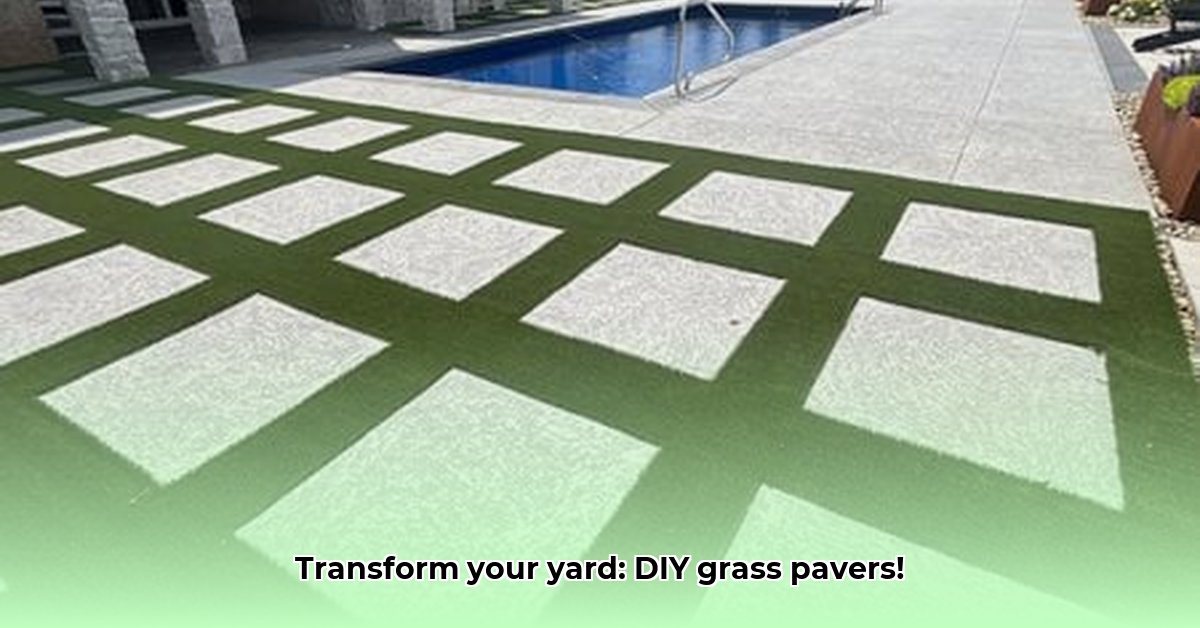Want a beautiful, eco-friendly walkway that enhances your outdoor space? This comprehensive guide provides a step-by-step approach to building a stunning paver walkway with grass. We’ll delve into selecting the ideal pavers and grass types, mastering the installation process, and ensuring long-term maintenance. Learn how to avoid common pitfalls, explore design options, and create a walkway that complements your home’s aesthetic. For more on grass selection, check out this helpful resource: grass selection guide. Let’s transform your landscape and create a dream walkway!
Pavers with Grass in Between: A Pathway to Natural Beauty
Creating a walkway using pavers with grass is a fantastic DIY project that seamlessly blends hardscape and softscape, adding character and curb appeal to your property. This guide provides everything from initial planning to ongoing care, helping you design a pathway that reflects your personal style and stands the test of time.
Planning Your Green Paver Path: Design, Layout, and Considerations
Before you begin, careful planning is essential. Start by measuring the area where your walkway will be located. Then, sketch a detailed layout; this helps visualize the design, estimate material quantities, and identify potential challenges. Consider the walkway’s purpose – is it primarily decorative or a frequently used path? This will influence your material choices and construction methods.
Think about how the walkway will integrate with your garden or existing landscape. Will it connect different areas, lead to a focal point, or simply add visual interest? Also, research local building codes and regulations to determine if any permits are required for your project.
Choosing the Right Materials: Pavers, Grass, and Aesthetic Harmony
Selecting the right pavers and grass is crucial to the success and longevity of your walkway. Let’s explore the various options, considering aesthetics, durability, cost, and maintenance requirements.
Pavers:
- Concrete Pavers: Cost-effective and durable, offering a wide range of shapes, sizes, colors, and textures. Easy to install and readily available at most home improvement stores.
- Brick Pavers: Classic and timeless, offering warmth and character to any landscape. Available in various colors and patterns, but may require sealing to protect against the elements.
- Natural Stone Pavers: Offer unique beauty and natural variations in color and texture. Add a touch of rustic elegance, but can be more expensive and require specialized installation skills.
- Recycled Pavers: Eco-friendly option made from recycled materials. Sustainable and durable.
| Paver Type | Pros | Cons | Cost |
|---|---|---|---|
| Concrete | Affordable, durable, easy to install, wide variety of shapes/sizes/colors, readily available | Can sometimes lack the unique character of natural stone, may fade over time | Low |
| Brick | Classic look, durable, warm and inviting, wide variety of colors and patterns | More expensive than concrete, may require sealing, can be susceptible to staining | Medium |
| Natural Stone | Unique appearance, durable, adds natural elegance | Most expensive, installation can be complex, requires specialized tools and skills, variations in size and thickness can make installation challenging | High |
| Recycled Pavers | Eco-friendly, durable, sustainable. | May have limited aesthetic options compared to traditional pavers. | Medium to High |
Grass:
Your grass choice should depend on your local climate, soil type, and maintenance preferences. Consider drought-tolerant varieties to minimize watering needs and promote sustainability. Artificial turf offers a low-maintenance alternative but lacks the natural look and feel of real grass.
Here are key factors to consider:
- Climate: Choose a grass type that thrives in your region’s climate (temperature, rainfall, sunlight).
- Soil Type: Consider your soil’s pH level, drainage, and nutrient content when selecting a grass type.
- Maintenance Level: Determine your willingness to mow, water, fertilize, and control weeds.
- Aesthetics: Choose a grass type that complements your paver selection and overall landscape design.
Building Your Pathway: A Step-by-Step Installation Guide
Now for the most rewarding part: constructing your paver walkway! Follow these steps carefully to ensure a successful and long-lasting installation:
- Ground Preparation: Clear the area of all vegetation, rocks, and debris. Excavate the soil to a depth of approximately 6-8 inches to accommodate the base layer and paver thickness.
- Base Layer Installation: Lay down a compacted base layer of gravel (4-6 inches thick). This provides drainage and a stable foundation for the pavers. Use a plate compactor to thoroughly compact the gravel base.
- Leveling Sand Layer: Spread a 1-2 inch layer of leveling sand over the compacted gravel base. Use a screed board to create a smooth, even surface for paver placement.
- Edge Restraint Installation: Install edge restraints along the perimeter of your pathway. These prevent the pavers from shifting and provide a clean, finished look. Options include plastic edging, metal edging, or concrete curbing.
- Paver Placement: Carefully lay your pavers on the prepared sand bed, maintaining consistent spacing between them for the grass. Use a rubber mallet to gently tap each paver into place and ensure it is level.
- Filling the Gaps: Fill the gaps between the pavers with topsoil or a specialized soil mix suitable for grass growth.
- Grass Planting: Sow grass seed or install sod in the prepared gaps between the pavers. Water thoroughly after planting.
- Compaction and Finishing: Use a plate compactor to gently compact the pavers and the surrounding soil, ensuring everything is level and stable. Add more topsoil as needed.
- Final Watering: Water the entire walkway thoroughly to encourage grass seed germination and root establishment.
Maintaining Your Masterpiece: Care and Preventative Measures
To keep your paver walkway looking its best for years to come, follow these maintenance guidelines:
- Regular Mowing: Mow the grass between the pavers regularly to maintain a uniform height and prevent it from overgrowing the pavers.
- Consistent Watering: Water the grass deeply and regularly, especially during dry periods, to promote healthy growth.
- Weed Control: Remove weeds that may sprout between the pavers or in the grass. Use a combination of hand-pulling and herbicides as needed.
- Fertilization: Fertilize the grass regularly with a balanced fertilizer to promote healthy growth and vibrant color.
- Paver Inspection and Repair: Periodically inspect the pavers for cracks, chips, or other damage. Replace any damaged pavers promptly to prevent further deterioration.
- Joint Sand Replenishment: Over time, the sand between the pavers may erode. Replenish the joint sand as needed to maintain stability and prevent weed growth.
Reflecting on Your Success: A Pathway to Pride and Enhanced Curb Appeal
Creating a paver walkway with grass is a rewarding project that enhances your outdoor space, adds value to your property, and provides years of enjoyment. Careful planning, proper installation, and consistent maintenance are the keys to achieving a beautiful and long-lasting result. The design possibilities are endless, allowing you to create a walkway that uniquely reflects your personal style and complements your home’s architecture.
DIY Pavers with Grass: Mastering the Art of Choosing the Best Grass Type for Paver Walkways
Key Takeaways:
- Selecting low-growing, drought-tolerant grasses is crucial for minimizing maintenance and ensuring long-term success.
- Thorough soil preparation, including amending compacted soil and ensuring adequate drainage, is essential for healthy grass growth and a successful walkway.
- Consistent watering, especially during the initial establishment phase, is vital for establishing a strong root system.
1. Planning Your Grassy Paver Paradise
Before you begin, careful planning is essential. Visualize your completed walkway. Consider the amount of sunlight the area receives. Sunny locations require drought-tolerant grasses, while shady areas benefit from shade-tolerant varieties. Careful planning prevents costly mistakes and ensures a thriving, beautiful walkway.
Determine the necessary materials, tools required, and if needed obtain any required permits.
2. Picking the Perfect Pavers and Grass: A Harmonious Combination
Choosing the right pavers is more than just aesthetics. Concrete pavers are budget-friendly and durable, brick offers timeless charm, and natural stone exudes elegance (though at a higher price point). Consider your budget, desired aesthetic, and the overall landscape design when making your selection.
Now, for the star of the show: how to choose the best grass type for paver walkways.
| Grass Type | Pros | Cons | Sun Tolerance | Foot Traffic Tolerance | Maintenance |
|---|---|---|---|---|---|
| Bermuda Grass | Drought-tolerant, heat-tolerant, excellent wear resistance, self-repairing | Can be invasive, requires regular mowing, turns brown in winter | High | High | Moderate |
| St. Augustine Grass |
- Glass Backsplash: Ideas For a Stylish Kitchen Update - December 2, 2025
- Glass On Tile: A Stylish Kitchen Backsplash Option - December 1, 2025
- Glass Tiles for Kitchen: Style and Durability Tips - November 30, 2025










